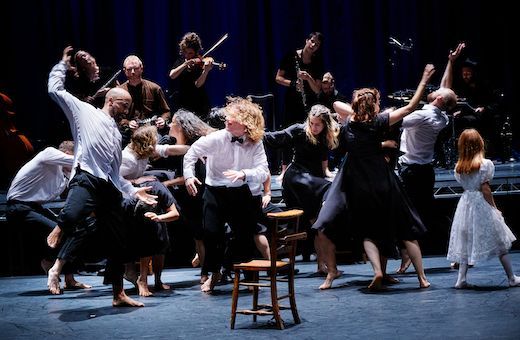Michael Keegan-Dolan has a solid reputation as one of the most gifted choreographers of our times. In past decades, he has created pieces as enduring and original as his versions of The Rite of the Spring and Swan Lake. These are works of theatre dance at its best, with a distinctive personality, a personal scenic language and formidable emotional depth. His latest creation, MÁM (2020), performed at Madrid’s Teatros del Canal, has a similar claim.

Created in collaboration with his Ireland-based company Teaċ Daṁsa, MÁM stems from Keegan’s Irish roots. The work is a subtlety set in a pub; there are a few chairs, a table and the presence of musicians onstage, as in many an Irish pub. The movement vocabulary is infused with movements that recall Irish folk dancing, Irish tap and social couple dancing. The music has a strong Irish component. Cormac Begley, a concertina player from West Kerry, leads the score for much of the evening. With these ingredients, Keegan’s choreography builds on the idea of belonging to a community, one that is welcoming, warm and fun, but that can also be fierce and brutal. Keegan shapes this communal experience from his childhood memories, but his portrayal transcends his Irish background, becoming universal. The Spanish audience at this performance certainly connected with the human experience portrayed onstage.
Keegan-Dolan’s dance language is a powerful vehicle for such a chronicle of life. His movements are lively and sparkling, yet also quiet and non-emphatic. They flow with seamless fluency, becoming hypnotic at times. An important reason for its successful force is the symbiotic relationship with the music. In addition to Begley's concertina, the pan-European music ensemble s t a r g a z e adds to the contemporary touches of the choreography. This is a small, experimental orchestra of classically trained musicians which projects warmth as well as a sense of novelty.
The rest of the scenic elements complement the kinetic and aural atmosphere elegantly. The set design by Sabine Dargent is austere yet most effective (the change of backcloths marking the change of scenes is brilliant). Hyemi Shin’s costumes in black and white enhance the expressivity of the dancing bodies with simplicity, and Adam Silverman’s lighting helps shift the focus from the individual to the communal, reinforcing the driving thread of the piece.
Amid the fine artistic contributions, Teaċ Daṁsa’s dancers excelled in their game. They danced lyrically, with precision and conviction. They were vividly expressive, and more significantly, they transmitted a sense of cohesion while preserving an individual distinctive presence onstage. This is a rare merit in the current dance panorama, dominated by uniformity and cold technical brilliance. Even the little girl in white (Keegan’s own daughter), who is a mute witness of – and an occasional participant in – the action, performed with such poise that her presence was as touching and compelling as that of the rest of the dancers.


